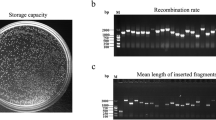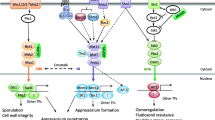Abstract
Adenylate cyclase (MAC1) and the catalytic subunit of cAMP-dependent protein kinase A (CPKA) are required for appressorium development and pathogenesis in the rice blast pathogen Magnaporthe grisea. To identify new components in the cAMP signal transduction pathway, we used the yeast two-hybrid system to screen MAC1 and CPKA against an appressorium cDNA library. The cDNA library was constructed by GATEWAY recombinational cloning, enabling transfer of the library to various alternative vectors. The protein phosphatase domain in MAC1, which is unique to fungal adenylate cyclases, interacted with a MAP kinase kinase and a Ser/Thr kinase. Interactions of MAC1 with the kinases may prove to be part of feedback loops between the corresponding signaling pathways. A predicted membrane protein, ACI1, which is highly expressed under conditions that are conducive to appressorium formation, also interacted with MAC1. ACI1 has an extracellular domain containing eight-cysteines, which is also present in other fungal proteins implicated in pathogenesis. The N-terminal half of CPKA, which includes a glutamine-rich sequence unique to a group of fungal sequences, interacted with a putative transcriptional regulator and two different glycosyl hydrolases. Phosphorylation motifs in these sequences suggest that they could be CPKA substrates. The protein interaction assay employed here can now be scaled up to identify interactions between a larger set of proteins in the M. grisea interactome.


Similar content being viewed by others
References
Adachi K, Hamer JE (1998) Divergent cAMP signaling pathways regulate growth and pathogenesis in the rice blast fungus Magnaporthe grisea. Plant Cell 10:1361–1373
Appella E, Weber IT, Blasi F (1988) Structure and function of epidermal growth factor-like regions in proteins. FEBS Lett 231:1-4
Bauman AL, Scott JD (2002) Kinase- and phosphatase-anchoring proteins: harnessing the dynamic duo. Nature Cell Biol 4:E203-E206
Beckerman JL, Naider F, Ebbole DJ (1997) Inhibition of pathogenicity of the rice blast fungus by Saccharomyces cerevisiae α-factor. Science 276:1116–1119
Brandhorst T, Wuthrich M, Finkel-Jimenez B, Klein B (2003) A C-terminal EGF-like domain governs BAD1 localization to the yeast surface and fungal adherence to phagocytes, but is dispensable in immune modulation and pathogenicity of Blastomyces dermatitidis. Mol Microbiol 48:53–65
Cabib E, Roh D-H, Schmidt M, Crotti LB, Varma A (2001) The yeast cell wall and septum as paradigms of cell growth and morphogenesis. J Biol Chem 276:19679–19682
Chen P, Lee KS, Levin DE (1993) A pair of putative protein kinase genes ( YPK1and YPK2) is required for cell growth in Saccharomyces cerevisiae. Mol Gen Genet 236:443–447
Choi W, Dean RA (1997) The adenylate cyclase gene MAC1 of Magnaporthe grisea controls appressorium formation and other aspects of growth and development. Plant Cell 9:1973–1983
Dean RA (1997) Signal pathways and appressorium morphogenesis. Annu Rev Phytopathol 35:211–234
DeJong JC, McCormack BJ, Smirnoff N, Talbot NJ (1997) Glycerol generates turgor in rice blast. Nature 389:244–245
DeZwaan TM, Carroll AM, Valent B, Sweigard JA (1999) Magnaporthe grisea Pth11p is a novel plasma membrane protein that mediates appressorium differentiation in response to inductive substrate cues. Plant Cell 11:2013–2030
Fang Y, Macool DJ, Xue Z, Heppard EP, Hainey CF, Tingey SV, Miao GH (2002) Development of a high-throughput yeast two-hybrid screening system to study protein-protein interactions in plants. Mol Genet Genomics 267:142–153
Foster AJ, Jenkinson JM, Talbot NJ (2003) Trehalose synthesis and metabolism are required at different stages of plant infection by Magnaporthe grisea. EMBO J 22:225–235
Gavin AC, (2002) Functional organization of the yeast proteome by systematic analysis of protein complexes. Nature 415:141–147
Gilbert RD, Johnson AM, Dean RA (1996) Chemical signals responsible for appressorium formation in the rice blast fungus Magnaporthe grisea. Physiol Mol Plant Pathol 48:335–346
Ho Y, et al (2002) Systematic identification of protein complexes in Sacharomyces cerevisiae by mass spectroscopy. Nature 415:180–183
Horton RM, Hunt HD, Ho SN, Pullen JK, Pease LR (1989) Engineering hybrid genes without the use of restriction enzymes: gene splicing by overlap extension. Gene 77:61–80
Howard RJ, Ferrari MA, Roach DH, Money NP (1991) Penetration of hard substrates by a fungus employing enormous turgor pressures. Proc Natl Acad Sci USA 88:11281–11284
Irie K, Takase M, Lee KS, Levin DE, Araki H, Matsumoto K, Oshima Y (1993) MKK1 and MKK2, which encode Saccharamyces cerevisiae mitogen-activated protein kinase-kinase homologs, function in the pathway mediated by protein kinase C. Mol Cell Biol 13:3076–3083
Ito T, Chiba T, Ozawa R, Yoshida M, Hattori M, Sakaki Y (2001) A comprehensive two-hybid analysis to explore the yeast protein interactome. Proc Natl Acad Sci USA 98:4569–4574
John M, Rohrig H, Schmidt J, Wieneke U, Schell J (1993) Rhizobium NodB protein involved in nodulation signal synthesis is a chitooligosaccharide deacetylase. Pro Natl Acad Sci USA 90:625–629
Kulkarni RD, Kelkar HS, Dean RA (2003) An eight-cysteine-containing CFEM domain unique to a group of fungal membrane proteins. Trends Biochem Sci 28:118–121
Lamarre C, Deslauriers N, Bourbonnais Y (2000) Expression cloning of the Candida albicans CSA1 gene encoding a mycelial surface antigen by sorting of Saccharomyces cerevisiae transformants with monoclonal antibody-coated magnetic beads. Mol Microbiol 35:444–453
Lee SC, Lee YH (1998) Calcium/calmodulin-dependent signaling for appressorium formation in the plant pathogenic fungus Magnaporthe grisea. Mol Cells 8:698–704
Lee YH, Dean RA (1993) cAMP regulates infection structure formation in the plant pathogenic fungus Magnaporthe grisea. Plant Cell 5:693–700
Liu S, Dean RA (1997) G protein α subunit genes control growth, development, and pathogenicity of Magnaporthe grisea. Mol Plant-Micro Interac 10:1075–1086
Liu ZM, Kolattukudy PE (1999) Early expression of the calmodulin gene, which precedes appressorium formation in Magnaporthe grisea, is inhibited by self-inhibitors and requires surface attachment. J Bacteriol 181:3571–3577
McCafferty HRK, Talbot NJ (1998) Identification of three ubiquitin genes of the rice blast fungus Magnaporthe grisea,one of which is highly expressed during initial stages of plant colonisation. Curr Genet 33:352–361
Mintzer KA, Field J (1999) The SH3 domain of the S. cerevisiae Cdc25p binds adenylyl cyclase and facilitates Ras regulation of cAMP signalling. Cell Signal 11:127–135
Mitchell TK, Dean RA (1995) The cAMP-dependent protein kinase catalytic subunit is required for appressorium formation and pathogenesis by the rice blast pathogen Magnaporthe grisea. Plant Cell 7:1869–1878
Mitts MR, Bradshaw-Rouse J, Heideman W (1991) Interactions between adenylate cyclase and the yeast GTPase-activating protein IRA1. Mol Cell Biol 11:4591–4598
Nishida Y, Shima F, Sen H, Tanaka Y, Yanagihara C, Yamawaki-Kataoka Y, Kariya K, Kataoka T (1998) Coiled-coil interaction of N-terminal 36 residues of cyclase-associated protein with adenylyl cyclase is sufficient for its function in Saccharomyces cerevisiae ras pathway. J Biol Chem 273:28019–28024
Peng T, Orsborn KI, Orbach MJ (1999) Proline-rich vaccine candidate antigen of Coccidioides immitis: Conservation among isolates and differential expression with spherule maturation. J Infect Dis 179:518–521
Robertson LS, Fink GR (1998) The three yeast A kinases have specific signaling functions in pseudohyphal growth. Proc Natl Acad Sci USA 95:13783–13787
Roche P, Maillet F, Plazanet C, Debelle F, Ferro M, Truchet G, Prome JC, Denarie J (1996) The common nodABC genes of Rhizobium meliloti are host-range determinants. Proc Natl Acad Sci USA 93:15305–15310
Schmelzle T, Helliwell SB, Hall MN (2002) Yeast protein kinases and the RHO1 exchange factor TUS1 are novel components of the cell integrity pathway in yeast. Mol Cell Biol 22:1329–1339
Taylor SS (1989) cAMP-dependent protein kinase. J Biol Chem 264:8443–8446
Thines E, Weber RWS, Talbot NJ (2000) MAP kinase and protein kinase A-dependent mobilization of triacylglycerol and glycogen during appressorium turgor generation by Magnaporthe grisea. Plant Cell 12:1703–1718
Thompson JD, Higgins DG, Gibson TJ (1994) CLUSTAL W: Improving the sensitivity of progressive multiple sequence alignment through sequence weighting, position-specific gap penalties and weight matrix choice. Nucleic Acids Res 22:4673–4680
Tucker SL, Talbot NJ (2001) Surface attachment and pre-penetration stage development by plant pathogenic fungi. Annu Rev Phytopathol 39:385–417
Uetz P, et al (2000) A comprehensive analysis of protein-protein interactions in Saccharomyces cerevisiae. Nature 403:623–627
Wang Z, Thornton CR, Kershaw MJ, Debao L, Talbot NJ (2003) The glyoxylate cycle is required for temporal regulation of virulence by the plant pathogenic fungus Magnaporthe grisea. Mol Microbiol 47:1601–1612
Xu JR, Hamer JE (1996) MAP kinase and cAMP signaling regulate infection structure formation and pathogenic growth in the rice blast fungus Magnaporthe grisea. Genes Dev 10:2696–2706
Xu JR, Staiger CJ, Hamer JE (1998) Inactivation of the mitogen-activated protein kinase Mps1 from the rice blast fungus prevents penetration of host cells but allows activation of plant defense responses. Proc Natl Acad Sci USA 95:12713–12718
Zhu H, Klemic JF, Chang S, Bertone P, Casamayor A, Klemic KG, Smith D, Gerstein M, Reed M, Snyder M (2000) Analysis of yeast protein kinases using protein chips. Nat Genet 26:283–289
Acknowledgements
We thank Jun-Seop Jeong for an aliquot of the appressorium cDNA library and Albert Flavier for construction of the MAC1-1 clone. This work was supported by funds from North Carolina Agricultural Research Service and the National Science Foundation (0096210)
Author information
Authors and Affiliations
Corresponding author
Additional information
Communicated by E. Cerdá-Olmedo
Rights and permissions
About this article
Cite this article
Kulkarni, R.D., Dean, R.A. Identification of proteins that interact with two regulators of appressorium development, adenylate cyclase and cAMP-dependent protein kinase A, in the rice blast fungus Magnaporthe grisea . Mol Genet Genomics 270, 497–508 (2004). https://doi.org/10.1007/s00438-003-0935-y
Received:
Accepted:
Published:
Issue Date:
DOI: https://doi.org/10.1007/s00438-003-0935-y




